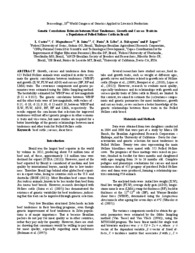Genetic correlations estimate between meat tenderness, growth and carcass traits in a population of polled nellore cattle in Brazil.
Genetic correlations estimate between meat tenderness, growth and carcass traits in a population of polled nellore cattle in Brazil.
Author(s): CASTRO, L.; MAGNABOSCO, C. de U.; GONZALEZ, R. D. S.; FARIA, C.; LÔBO, R.; NAKAGAWA, A.; LOPES, F.
Summary: Growth, carcass and tenderness data from 415 Polled Nellore animals were analyzed in order to estimate the genetic correlations between tenderness (WBSF) and growth (ILW, FLW and ADG) and carcass (BF, RF and LMA) traits. The covariance components and genetic parameters were estimated using the Gibbs Sampling method. The heritability estimated for WBSF was of low magnitude (0.11 ± 0.022). The genetic correlations between WBSF and the other traits were of low magnitude, with values of - 0.15; -0.18; -0.13; 0.10; -0.12 and 0.18, between WBSF and ILW, FLW, ADG, BF, RF and LMA, respectively. The results support the conclusion that selection for improved tenderness will not affect genetic progress in other economic traits and vice-versa, but more studies are required for a better knowledge of the genetic relationships between meat tenderness and other traits for Polled Nellore cattle.
Publication year: 2014
Types of publication: Paper in annals and proceedings
Unit: Embrapa Cerrados
Keywords: Bovinos de corte, Carcass, Carcaça, Força de cisalhamento, Gado de corte, Shear force, beef cattle
Observation
Some of Embrapa's publications are published as ePub files. To read them, use or download one of the following free software options to your computer or mobile device. Android: Google Play Books; IOS: iBooks; Windows and Linux: Calibre.
Access other publications
Access the Agricultural Research Database (BDPA) to consult Embrapa's full library collection and records.
Visit Embrapa Bookstore to purchase books and other publications sold by Embrapa.

